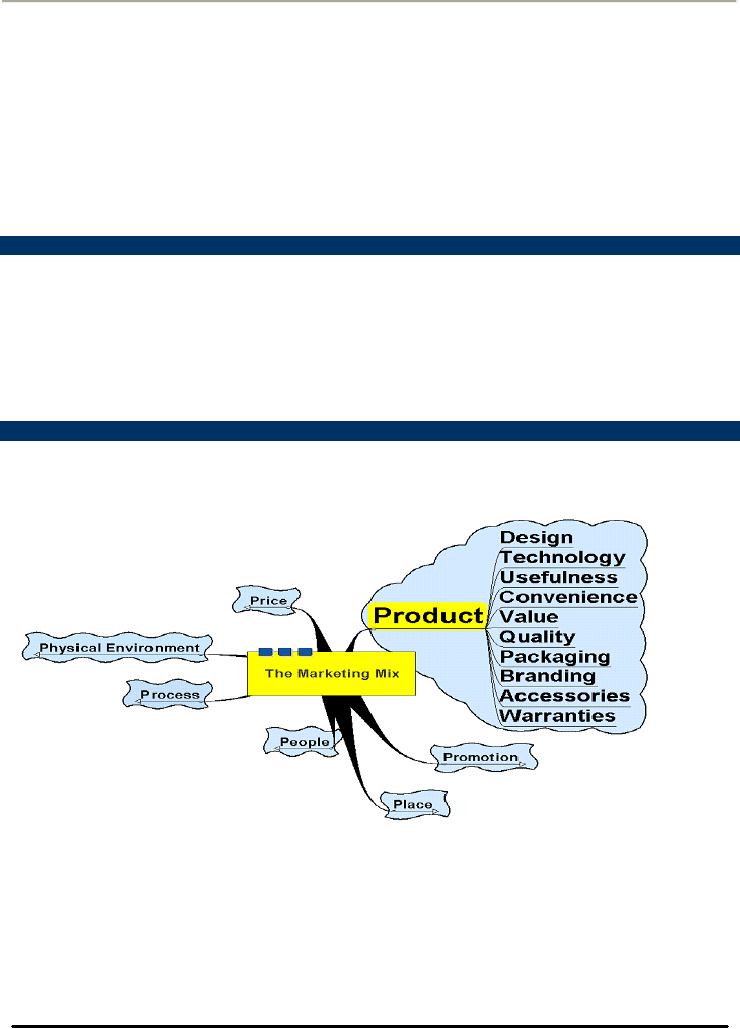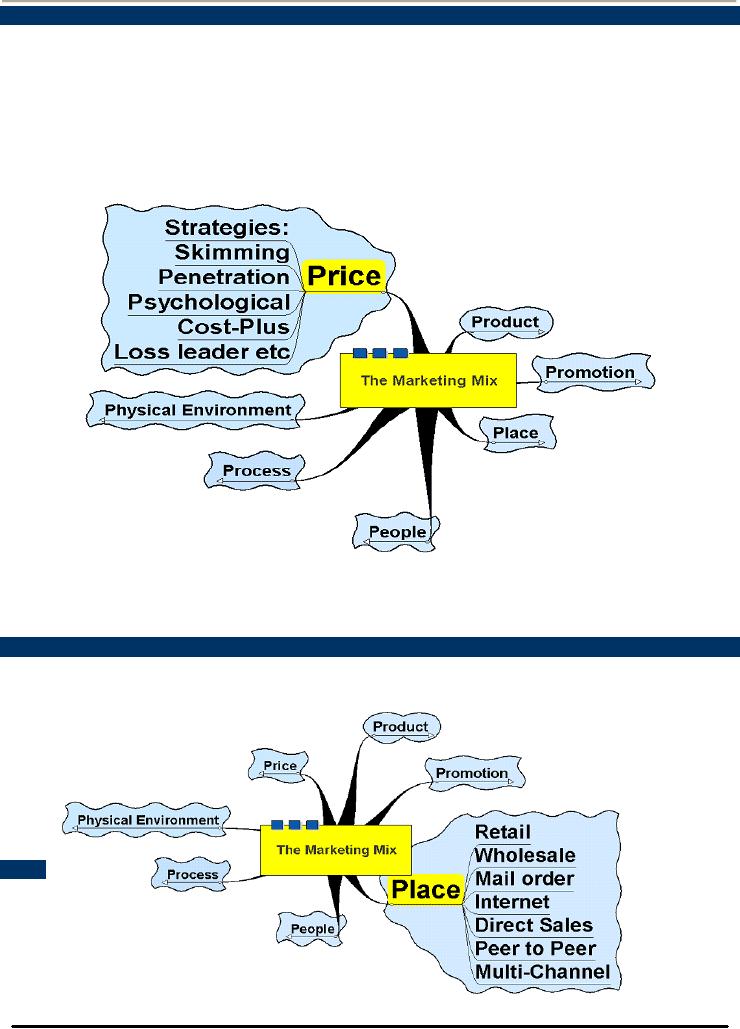 |
INTRODUCTION TO CONSUMER PSYCHOLOGY:Marketing Mix, Product, Price |
| << INTRODUCTION TO CONSUMER PSYCHOLOGY:Consumer research |
| INTRODUCTION TO CONSUMER PSYCHOLOGY:Customer Value, Perceived Value >> |

Consumer
Psychology (PSY -
514)
VU
Lesson
03
INTRODUCTION
TO CONSUMER PSYCHOLOGY
(MARKETING
MIX)
OBJECTIVES:
Introducing
the Concept of Marketing
Mix
o
Understanding
the four elements of Marketing
Mix::
Product
Price
Place
Promotion
o
Services
Marketing
Mix
Marketing
Mix consists of the tools
available to a business to gain the
reaction it is seeking from its
target market
in
relation to its marketing objectives. It
consists of company's services/and or
products offerings to consumers
and
methods and tools it uses to
accomplish the exchange. The marketing
mix consists of four
elements:
1.
Product
or Service
2.
The
Price
3.
The
Place
4.
Promotion
1.
Product
Product
is anything that consumer
acquires or might acquire to
meet a perceived need. Product
features, design,
brands,
and packaging offered along
with post purchase benefits
such as warranties and
return policies.
Consumers
don't
purchase physical features of a
product, they buy the perceived
benefits.
Various
ways are used to
improve/differentiate the product and
increase sales or target
sales more effectively
to
gain
a competitive advantage e.g.
some of the ways are:
�
Extension
strategies
�
Specialised
versions
�
New
editions
�
Improvements
real or otherwise!
�
Changed
packaging
�
Technology,
etc.
8

Consumer
Psychology (PSY -
514)
VU
2.
Price
Price
is the amount of money one must
pay to obtain the right to
use the product. This means
the list price,
including
discounts, allowances, and
payment methods.
Economists
often assume that lower
prices will result in higher
sales. Price sometimes
serves as signal of
quality
also.
A product priced too low
might be perceived as having very low
quality and a product priced
too high might
be
perceived as of a very high quality.
Simultaneously, owning an expensive item
also provides information
about
the
consumer. It can dictate
that the owner can afford an
expensive item
It
is important here to note
that the price of a product is
not the same as the cost of the
product.
Consumer
Cost is everything a
consumer must surrender to
receive the benefits of owning/using the
products.
3.
Place
Having
the product available where the
target consumers could purchase
it. The distribution of
product or services
may
be made through specific
stores and non-store outlets.
9

Consumer
Psychology (PSY -
514)
VU
4.
Promotion
Promotion
consists of Strategies to make the
consumer aware of the existence of a
product
or
service. This includes
advertising, sales promotion,
public relations, and sales
efforts designed to
build
awareness
and demand for the product
or services. Promotion is NOT just
advertising
The
basis of successful promotion is
developing an effective communication strategy and an
effective
communication
strategy requires answers to
certain important questions. Which
are:
The
Five Questions of
Promotion
1.
With
whom exactly do we want to
communicate?
2.
What
effect do we want our communications to
have on our target
consumers?
3.
What
message will achieve the
desired impact on our
audience?
4.
What
means and media should we
use to reach the target
audience?
5.
What
should we communicate with our
audience?
a)
With whom
exactly do we want to communicate?
�
Target
Market Member
�
Channel
Members
�
Example:
Pediatric nurses are often
asked for advice concerning
diapers and other non
medical infant
care.
A firm marketing such items
will be wise to communicate
with such individuals
directly in their
promotion
b)
What effect do
we want our communications to
have on our target
consumers?
Often
a manger will state that the
ultimate objective of all communications is to
improve the sales, while this
may
be
the ultimate objective, however, the behavioral objectives
are often of much more
importance. It may seek to
provide
more information to the audience,
educate the audience on certain
features of the product,
recommend
the
product to others, feel good about having
bought the product,
etc..
c)
What message
will achieve the desired
impact on our
audience?
What
words, pictures visuals will
be used, how a particular word is
interpreted by the target audience, what
kind of
symbolism
may be used.
d)
What means and
media should we use to reach
the target
audience?
Can
we rely on the packaging of the product to
provide information or should we use
media, and if so what type
of
media should we use
e)
What should we
communicate with our
audience?
Should
we concentrate in our communications
near the time purchase tend to be
madder or evenly through
out
the
week or the month? Do consumers seek
out information shortly before the
purchase of our product? If
so,
then
where? Answering these questions
requires knowledge of the decision
process used by the target
market for
this
product.
5.
Services
Earlier
we defined product to include services.
The services products may be
like medical treatments, car
repairs or
haircut;
however, in this section we are
discussing services to refer to auxiliary or
peripheral activities that are
performed
to enhance the primary product or
service. For example a fast
food restaurant may offer
fee delivery; a
car
repair shop may offer free
pick up and delivery.
Auxiliary services are used
add tactical advantage to a
certain
product
and these cost money to the
company. Therefore, these must be planned
carefully and only those
services
need
to be added that will
provide maximum value to the
consumers.
10
Table of Contents:
- INTRODUCTION TO CONSUMER PSYCHOLOGY:Consumer Behavior
- INTRODUCTION TO CONSUMER PSYCHOLOGY:Consumer research
- INTRODUCTION TO CONSUMER PSYCHOLOGY:Marketing Mix, Product, Price
- INTRODUCTION TO CONSUMER PSYCHOLOGY:Customer Value, Perceived Value
- VALUE AND RETENTION FOCUSED MARKETING AND CONSUMER DECISION MAKING PROCESS
- CONSUMER RESEARCH:Quantitative Research, Qualitative Research
- MAJOR STEPS IN CONSUMER RESEARCH PROCESS:Design of Primary research
- QUANTITATIVE RESEARCH DESIGNS & DATA COLLECTION METHODS
- QUANTITATIVE RESEARCH DATA COLLECTION TECHNIQUES:ATTITUDE SCALES
- QUALITATIVE RESEARCH DESIGNS & DATA COLLECTION METHODS
- CUSTOMER SATISFACTION MEASUREMENT, SAMPLING, AND DATA ANALYSIS AND REPORTING
- MARKET SEGMENTATION AND ITS BASES:Geographical Segmentation
- BASES FOR SEGMENTATION: DEMOGRAPHIC SEGMENTATION PSYCHOGRAPHIC SEGMENTATION
- BASES FOR SEGMENTATION: SOCIOCULTURAL SEGMENTATION USE RELATED SEGMENTATION USAGE SITUATION SEGMENTATION
- BASES FOR SEGMENTATION: BENEFIT SEGMENTATION:Intrinsic Cues
- BASES FOR SEGMENTATION: HYBRID SEGMENTATION STRATEGIES
- MARKET SEGMENTATION IMPLEMENTING SEGMENTATION STRATEGIES ENVIRONMENTAL INFLUENCES CULTURE
- HOW CULTURE IS LEARNT ENVIRONMENTAL INFLUENCES:Formal Learning
- CULTURE AND ITS MEASUREMENT ENVIRONMENTAL INFLUENCES
- MEASUREMENT OF CULTURE ENVIRONMENTAL INFLUENCES:Consumer Fieldwork
- SUBCULTURE CHAPTER 4: ENVIRONMENTAL INFLUENCES
- AGE AND GENDER SUBCULTURE CHAPTER 4: ENVIRONMENTAL INFLUENCES
- BASES FOR SEGMENTATION: BENEFIT SEGMENTATION:Market Segmentation
- SOCIAL CLASS CHAPTER 4: ENVIRONMENTAL INFLUENCES:Occupation
- CONSUMER SOCIAL CLASSES CHAPTER 4: ENVIRONMENTAL INFLUENCES:Affluent Consumer
- CONSUMER SOCIAL CLASSES CHAPTER 4: ENVIRONMENTAL INFLUENCES:Membership Group
- CONSUMER SOCIAL CLASSES CHAPTER 4: ENVIRONMENTAL INFLUENCES:Shopping Groups
- UNDERSTANDING PERSONALITY CHAPTER 5: INDIVIDUAL DETERMINANTS OF CONSUMER BEHAVIOR
- CONSUMER PERSONALITY, TRAIT THEORY AND SELF IMAGES
- CONSUMER MOTIVATION:Needs, Goals, Generic Goals
- UNDERSTANDING LEARNING:Intentional and Incidental Learning, Implications for Marketers
- INSTRUMENTAL CONDITIONING, INFORMATION PROCESSING AND MEMORY
- ATTITUDES:Characteristics of Attitudes, Attitudes have consistency
- ATTITUDE FORMATION AND CHANGE:How attitudes are learned?
- ATTITUDE CHANGE STRATEGIES:Resolving two conflicting attitudes
- INTRODUCTION TO CONSUMER DECISION MAKING:Decision Complexity
- Problem Recognition, Search and Evaluation and Decision and Purchase
- Decision and Purchase:Consumer Decision Rules, Output, Relationship Marketing
- Decisions Related to Post Purchase:Product Set up and Use
- Marketing Implications of Decisions Related to Post Purchase:Understanding
- Post Purchase Evaluation:Determinants of Satisfaction, Consumer Complaint Behavior
- Post Purchase Dissonance:Dissonance Reduction, Marketing Implications
- Consumerism:Roots of Consumerism, The Nature of Consumerism
- Consumerism – Issues and Responses:Environmental Concerns, Consumer Privacy
- Review – Consumer Psychology Course:Consumer Research, Consumerism